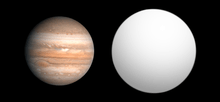XO-3b
XO-3b is an exoplanet with about 11.79 times the mass of Jupiter, and an orbit around its parent star in about 3.2 days.[5] The radius of this object is 1.217 times that of Jupiter. Astronomers announced their discovery on May 30, 2007, at the American Astronomical Society in Honolulu, Hawaii. Its discovery is attributed to the combined effort of amateur and professional astronomers working together on the XO Project using a telescope located on the Haleakala summit in Hawaii.[6]
 Size comparison of XO-3b with Jupiter. | |
| Discovery | |
|---|---|
| Discovered by | XO Project[1] |
| Discovery site | XO telescope Maui, Hawaii[1] |
| Discovery date | May 30, 2007 |
| Transit, Radial velocity[1] | |
| Orbital characteristics | |
| 0.0454 ± 0.00082 AU (6,792,000 ± 123,000 km)[2] | |
| Eccentricity | 0.2883 ± 0.0025[3] |
| 3.1915289 ± 0.0000032[4] d | |
| Inclination | 84.20 ± 0.54[2] |
| 346.1+1.2 −1.1[3] | |
| Semi-amplitude | 1494.0 ± 9.5[3] |
| Star | XO-3 |
| Physical characteristics | |
Mean radius | 1.217 ± 0.073[2] RJ |
| Mass | 11.79 ± 0.59[2] MJ |
Dubbed an "oddball" planet, the planet stands out from over 350 other extrasolar planets as the most massive planet found in close proximity to a star, yet the orbit is significantly elliptical instead of circular, as would be expected.[6] It is also considered a transiting planet, passing in front of its parent star during each orbit. It is the third such planet to be found by the XO Project which was specifically created to locate them.[7]
Orbital inclination and eccentricity
Measurements of the Rossiter–McLaughlin effect allow a determination of the angle between the planet's orbital plane and the equator of the parent star. Initial reports suggested this angle was very large, at 70 ± 15 degrees,[8] which is significantly larger than that of the other transiting planets for which this measurement has been made.[9] The authors cautioned that systematic effects may have affected the measurements, and a later determination by an independent group of astronomers determined a reduced value of 37.3±3.0°.[10] This value is however still larger than the misalignment between the Sun's equator and the orbital plane of Jupiter, which is only 6°.[4]
The misalignment may indicate that in the past an encounter with another planet altered its orbit, kicking it out of the plane of the planetary system. Its orbital eccentricity is very large (e = 0.2883). Since tidal forces should have reduced the orbital eccentricity of this planet it is possible that there is another massive planet outside the orbit of XO-3 that is in orbital resonance with XO-3b.[11] Another planetary system that may have also undergone such planet-planet interactions is Upsilon Andromedae.[12]
Debate
There is currently a debate over the classification of this object as either a planet or a brown dwarf. One of the leading astronomers in this discussion is Christopher Johns-Krull, who indicated that the debate is still quite lively. This is not particularly unusual or strange, as it would not be the first of many brown dwarfs orbiting mother stars.[5]
The light curve that better match the steepness of ingress and egress implies a planetary radius of 1.32 ± 0.15 RJ and a mass of 11.71 ± 0.46 MJ.[1]
See also
References
- Johns-Krull, Christopher M.; et al. (2008). "XO-3b: A Massive Planet in an Eccentric Orbit Transiting an F5V Star". The Astrophysical Journal. 677 (1): 657–670. arXiv:0712.4283. Bibcode:2008ApJ...677..657J. doi:10.1086/528950.
- Winn, Joshua N.; et al. (2008). "The Transit Light Curve Project. IX. Evidence for a Smaller Radius of the Exoplanet XO-3b". The Astrophysical Journal. 683 (2): 1076–1084. arXiv:0804.4475. Bibcode:2008ApJ...683.1076W. doi:10.1086/589737.
- Hirano, Teruyuki; et al. (2011). "Further Observations of the Tilted Planet XO-3: A New Determination of Spin-Orbit Misalignment, and Limits on Differential Rotation". Publications of the Astronomical Society of Japan. 63 (6): L57–L61. arXiv:1108.4493. Bibcode:2011PASJ...63L..57H. doi:10.1093/pasj/63.6.l57.
- Winn, Joshua N.; et al. (2009). "On the Spin-Orbit Misalignment of the XO-3 Exoplanetary System". The Astrophysical Journal. 700 (1): 302–308. arXiv:0902.3461. Bibcode:2009ApJ...700..302W. doi:10.1088/0004-637X/700/1/302.
- Oddball Planet Puzzles Astronomers, Space.com
- Space oddity: Astronomers discover giant planet, The Times of India
- XO-3 b: Supersized planet or oasis in the 'brown dwarf desert'?, EurekAlert!
- Hébrard, G.; et al. (2008). "Misaligned spin-orbit in the XO-3 planetary system?". Astronomy and Astrophysics. 488 (2): 763–770. arXiv:0806.0719. Bibcode:2008A&A...488..763H. doi:10.1051/0004-6361:200810056.(web preprint)
- Joshua N. Winn (2008). "Measuring accurate transit parameters". Proceedings of the International Astronomical Union. 4: 99–109. arXiv:0807.4929. Bibcode:2009IAUS..253...99W. doi:10.1017/S174392130802629X.
- Obliquities of Hot Jupiter host stars: Evidence for tidal interactions and primordial misalignments, 2012, arXiv:1206.6105
- Powell, Devin (2008-09-22). "Planet's strange orbit points to planetary billiards". New Scientist. Retrieved 2008-09-23.
- Ford, E.; et al. (2005). "Planet-planet scattering in the upsilon Andromedae system". Nature. 434 (7035): 873–876. arXiv:astro-ph/0502441. Bibcode:2005Natur.434..873F. doi:10.1038/nature03427. PMID 15829958.
External links
![]()
- {Norwegian} Kjempeplanet i farta - forskning.no 1.6.07